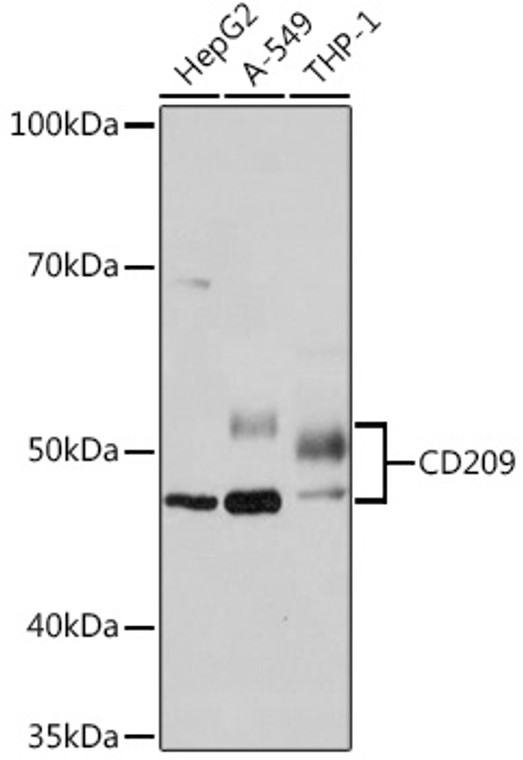| Host: |
Rabbit |
| Applications: |
WB/IHC/IF |
| Reactivity: |
Human/Mouse/Rat |
| Note: |
STRICTLY FOR FURTHER SCIENTIFIC RESEARCH USE ONLY (RUO). MUST NOT TO BE USED IN DIAGNOSTIC OR THERAPEUTIC APPLICATIONS. |
| Short Description: |
Rabbit monoclonal antibody anti-CD209 (1-100) is suitable for use in Western Blot, Immunohistochemistry and Immunofluorescence research applications. |
| Clonality: |
Monoclonal |
| Clone ID: |
S5MR |
| Conjugation: |
Unconjugated |
| Isotype: |
IgG |
| Formulation: |
PBS with 0.02% Sodium Azide, 0.05% BSA, 50% Glycerol, pH7.3. |
| Purification: |
Affinity purification |
| Dilution Range: |
WB 1:500-1:2000IHC-P 1:50-1:200IF/ICC 1:50-1:200 |
| Storage Instruction: |
Store at-20°C for up to 1 year from the date of receipt, and avoid repeat freeze-thaw cycles. |
| Gene Symbol: |
CD209 |
| Gene ID: |
30835 |
| Uniprot ID: |
CD209_HUMAN |
| Immunogen Region: |
1-100 |
| Immunogen: |
A synthetic peptide corresponding to a sequence within amino acids 1-100 of human CD209 (Q9NNX6). |
| Immunogen Sequence: |
MSDSKEPRLQQLGLLEEEQL RGLGFRQTRGYKSLAGCLGH GPLVLQLLSFTLLAGLLVQV SKVPSSISQEQSRQDAIYQN LTQLKAAVGELSEKSKLQEI |
| Tissue Specificity | Predominantly expressed in dendritic cells and in DC-residing tissues. Also found in placental macrophages, endothelial cells of placental vascular channels, peripheral blood mononuclear cells, and THP-1 monocytes. |
| Function | Pathogen-recognition receptor expressed on the surface of immature dendritic cells (DCs) and involved in initiation of primary immune response. Thought to mediate the endocytosis of pathogens which are subsequently degraded in lysosomal compartments. The receptor returns to the cell membrane surface and the pathogen-derived antigens are presented to resting T-cells via MHC class II proteins to initiate the adaptive immune response. On DCs it is a high affinity receptor for ICAM2 and ICAM3 by binding to mannose-like carbohydrates. May act as a DC rolling receptor that mediates transendothelial migration of DC presursors from blood to tissues by binding endothelial ICAM2. Seems to regulate DC-induced T-cell proliferation by binding to ICAM3 on T-cells in the immunological synapse formed between DC and T-cells. (Microbial infection) Acts as an attachment receptor for HIV-1 and HIV-2. (Microbial infection) Acts as an attachment receptor for Ebolavirus. (Microbial infection) Acts as an attachment receptor for Cytomegalovirus. (Microbial infection) Acts as an attachment receptor for HCV. (Microbial infection) Acts as an attachment receptor for Dengue virus. (Microbial infection) Acts as an attachment receptor for Measles virus. (Microbial infection) Acts as an attachment receptor for Herpes simplex virus 1. (Microbial infection) Acts as an attachment receptor for Influenzavirus A. (Microbial infection) Acts as an attachment receptor for SARS-CoV. (Microbial infection) Acts as an attachment receptor for Japanese encephalitis virus. (Microbial infection) Acts as an attachment receptor for Lassa virus. Acts as an attachment receptor for Marburg virusn. (Microbial infection) Acts as an attachment receptor for Respiratory syncytial virus. (Microbial infection) Acts as an attachment receptor for Rift valley fever virus and uukuniemi virus. (Microbial infection) Acts as an attachment receptor for West-nile virus. (Microbial infection) Probably recognizes in a calcium-dependent manner high mannose N-linked oligosaccharides in a variety of bacterial pathogen antigens, including Leishmania pifanoi LPG, Lewis-x antigen in Helicobacter pylori LPS, mannose in Klebsiella pneumonae LPS, di-mannose and tri-mannose in Mycobacterium tuberculosis ManLAM and Lewis-x antigen in Schistosoma mansoni SEA. Recognition of M.tuberculosis by dendritic cells occurs partially via this molecule. |
| Protein Name | Cd209 AntigenC-Type Lectin Domain Family 4 Member LDendritic Cell-Specific Icam-3-Grabbing Non-Integrin 1Dc-SignDc-Sign1Cd Antigen Cd209 |
| Database Links | Reactome: R-HSA-5621575Reactome: R-HSA-8851680 |
| Cellular Localisation | Isoform 1: Cell MembraneSingle-Pass Type Ii Membrane ProteinIsoform 2: Cell MembraneIsoform 3: Cell MembraneIsoform 4: Cell MembraneIsoform 5: Cell MembraneIsoform 6: SecretedIsoform 7: SecretedIsoform 8: SecretedIsoform 9: SecretedIsoform 10: SecretedIsoform 11: SecretedIsoform 12: Secreted |
| Alternative Antibody Names | Anti-Cd209 Antigen antibodyAnti-C-Type Lectin Domain Family 4 Member L antibodyAnti-Dendritic Cell-Specific Icam-3-Grabbing Non-Integrin 1 antibodyAnti-Dc-Sign antibodyAnti-Dc-Sign1 antibodyAnti-Cd Antigen Cd209 antibodyAnti-CD209 antibodyAnti-CLEC4L antibody |
Information sourced from Uniprot.org
12 months for antibodies. 6 months for ELISA Kits. Please see website T&Cs for further guidance













![Western blot analysis of various lysates using [KO Validated] MEK2 Rabbit monoclonal antibody (STJ11101615) at 1:1000 dilution. Secondary antibody: HRP Goat Anti-Rabbit IgG (H+L) (STJS000856) at 1:10000 dilution. Lysates/proteins: 25 Mu g per lane. Blocking buffer: 3% nonfat dry milk in TBST. Detection: ECL Basic Kit. Exposure time: 1s. Western blot analysis of various lysates using [KO Validated] MEK2 Rabbit monoclonal antibody (STJ11101615) at 1:1000 dilution. Secondary antibody: HRP Goat Anti-Rabbit IgG (H+L) (STJS000856) at 1:10000 dilution. Lysates/proteins: 25 Mu g per lane. Blocking buffer: 3% nonfat dry milk in TBST. Detection: ECL Basic Kit. Exposure time: 1s.](https://cdn11.bigcommerce.com/s-zso2xnchw9/images/stencil/300x300/products/90529/360110/STJ11101615_1__89635.1713124721.jpg?c=1)
